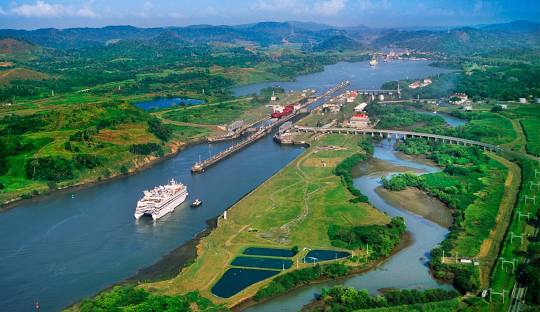
Current Situation of Panama Canal Ports: Challenges, Impact, and Future Outlook
The Panama Canal is one of the most strategically important waterways in global trade, serving as a critical conduit for cargo ships between the Atlantic and Pacific Oceans. However, recent challenges, including climate change, logistical bottlenecks, and geopolitical influences, have significantly affected its operations. This article delves into the current situation of the Panama Canal ports, analyzing the key issues, their economic impacts, and the future trajectory of this vital maritime trade hub.
Current Situation of Panama Canal Ports: Challenges, Impact, and Future Outlook
1. Overview of the Panama Canal and Its Significance
The Panama Canal, an artificial 82 km (51 mi) waterway, has been a crucial passage for maritime trade since its opening in 1914. It connects the Pacific and Atlantic Oceans, reducing shipping distances and fuel costs while enabling quicker transit for global commerce.
Why Is the Panama Canal Important?
✔️ Handles over 5% of global maritime trade.
✔️ Major route for LNG, oil, containerized cargo, and agricultural commodities.
✔️ Reduces the travel time for ships by up to two weeks compared to traditional routes.
✔️ Provides economic benefits to Panama’s GDP and employment sector.
However, the current challenges faced by the Panama Canal ports are threatening its efficiency and global importance.
Current Situation of Panama Canal Ports: Challenges, Impact, and Future Outlook
2. Current Challenges Affecting Panama Canal Ports
Several pressing issues are impacting the operations of the Panama Canal, leading to disruptions in global supply chains.
2.1 Water Shortage and Climate Change Impact
One of the biggest challenges is the severe drought conditions affecting the availability of freshwater, which is essential for the lock systems in the canal.
🔴 Water Levels Declining: The Gatun Lake, which supplies water for canal operations, has witnessed record-low water levels, leading to restrictions on vessel transits.
🔴 Reduced Cargo Capacity: Ships are now carrying less cargo to accommodate the decreased draft allowances, raising shipping costs.
🔴 Climate Variability: The El Niño phenomenon has exacerbated the drought situation, further limiting the water supply.
2.2 Logistical Bottlenecks and Congestion
Due to operational constraints, delays in vessel transits have been reported, causing disruptions in global supply chains.
🔴 Queue of Ships: A backlog of vessels is waiting for their turn, causing delays of several days to weeks.
🔴 Restrictions on Large Vessels: Large container ships are struggling to pass through due to draft restrictions, affecting bulk and energy shipments.
🔴 Increased Waiting Fees: Shipping companies are incurring higher costs due to waiting fees and rerouting options.
2.3 Geopolitical and Trade Disruptions
The global geopolitical landscape has also played a role in the Panama Canal’s current difficulties.
🔴 US-China Trade Tensions: With both countries being key users of the canal, any trade war or tariff adjustments affect shipping volumes.
🔴 Alternative Routes Competition: New shipping routes, such as the Arctic routes (affected by melting ice caps) and the Suez Canal, are emerging as competitors.
🔴 Security Concerns: Increasing risks of piracy, smuggling, and geopolitical conflicts in nearby regions add further concerns for trade operations.
Current Situation of Panama Canal Ports: Challenges, Impact, and Future Outlook
3. Economic and Trade Impact of the Panama Canal Issues
The Panama Canal’s situation has wide-ranging consequences for various sectors.
3.1 Global Supply Chain Disruptions
✔️ Delays in goods transportation lead to increased costs for manufacturers and retailers.
✔️ Higher freight costs affect companies depending on just-in-time inventory systems.
✔️ Consumers face rising prices due to increased shipping costs being passed down.
3.2 Impact on Panama’s Economy
✔️ The Panama Canal contributes nearly 6% to the country’s GDP, making it a critical economic asset.
✔️ Reduced revenue from toll fees is affecting the government’s budget.
✔️ Tourism and port-related industries are facing declining business due to trade slowdowns.
3.3 Effect on Alternative Trade Routes
✔️ The Suez Canal and Arctic Route are gaining traction as shipping companies seek alternatives.
✔️ US West Coast ports are seeing an increase in demand for trade with Asia.
✔️ Latin American trade hubs like the Colombia Canal proposal are being explored as alternative routes.
Current Situation of Panama Canal Ports: Challenges, Impact, and Future Outlook
4. Future Outlook and Possible Solutions
The future of the Panama Canal depends on effective policy decisions, investment in infrastructure, and climate adaptation measures.
4.1 Infrastructure and Water Management Improvements
✔️ New water reservoirs and enhanced rainwater conservation techniques are being explored.
✔️ The Panama Canal Authority (ACP) is considering a $2 billion investment in a water conservation system.
✔️ Dredging efforts are ongoing to maintain navigability.
4.2 Technological Innovations in Canal Operations
✔️ AI-based traffic management is being tested to improve efficiency.
✔️ Smart lock system upgrades to reduce water wastage.
✔️ Renewable energy integration to support operations sustainably.
4.3 Policy and Trade Adjustments
✔️ Negotiations with major trade partners to ensure continued canal usage.
✔️ Encouragement of alternative shipping models, such as smaller, more frequent shipments instead of large vessels.
✔️ Public-private partnerships to fund necessary infrastructure developments.
Current Situation of Panama Canal Ports: Challenges, Impact, and Future Outlook
Conclusion
The Panama Canal ports remain one of the most crucial arteries of global trade, but they are currently facing significant challenges due to climate change, logistical congestion, and geopolitical influences. While immediate solutions such as water management strategies, investment in infrastructure, and technological enhancements are being implemented, the long-term sustainability of the canal requires global cooperation and proactive policymaking.
With proper reforms and strategic planning, the Panama Canal can continue to be a vital trade route for decades to come. However, shipping companies and global trade stakeholders must prepare for evolving challenges by diversifying routes and adopting resilient logistics strategies.
Leave a Reply